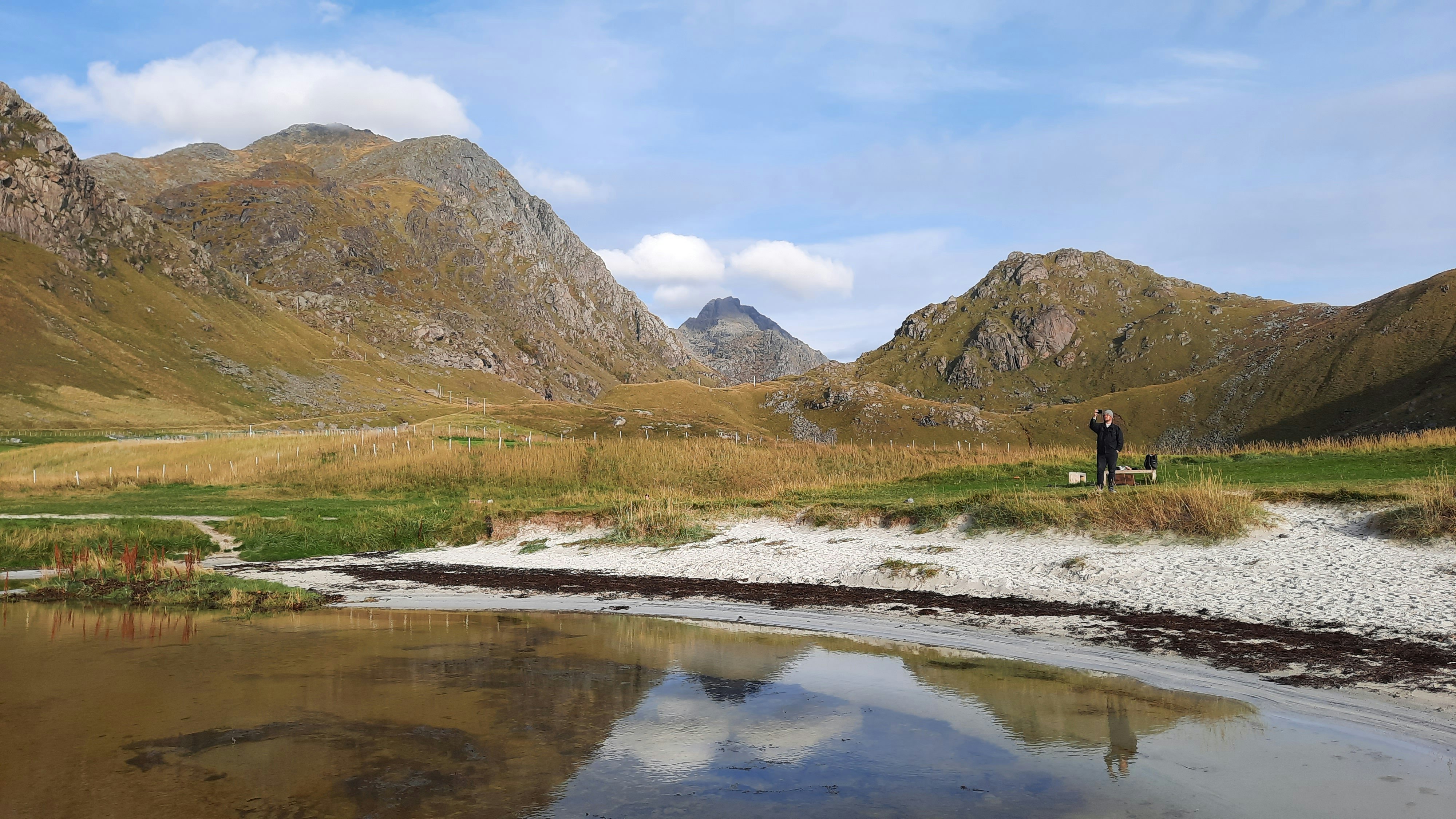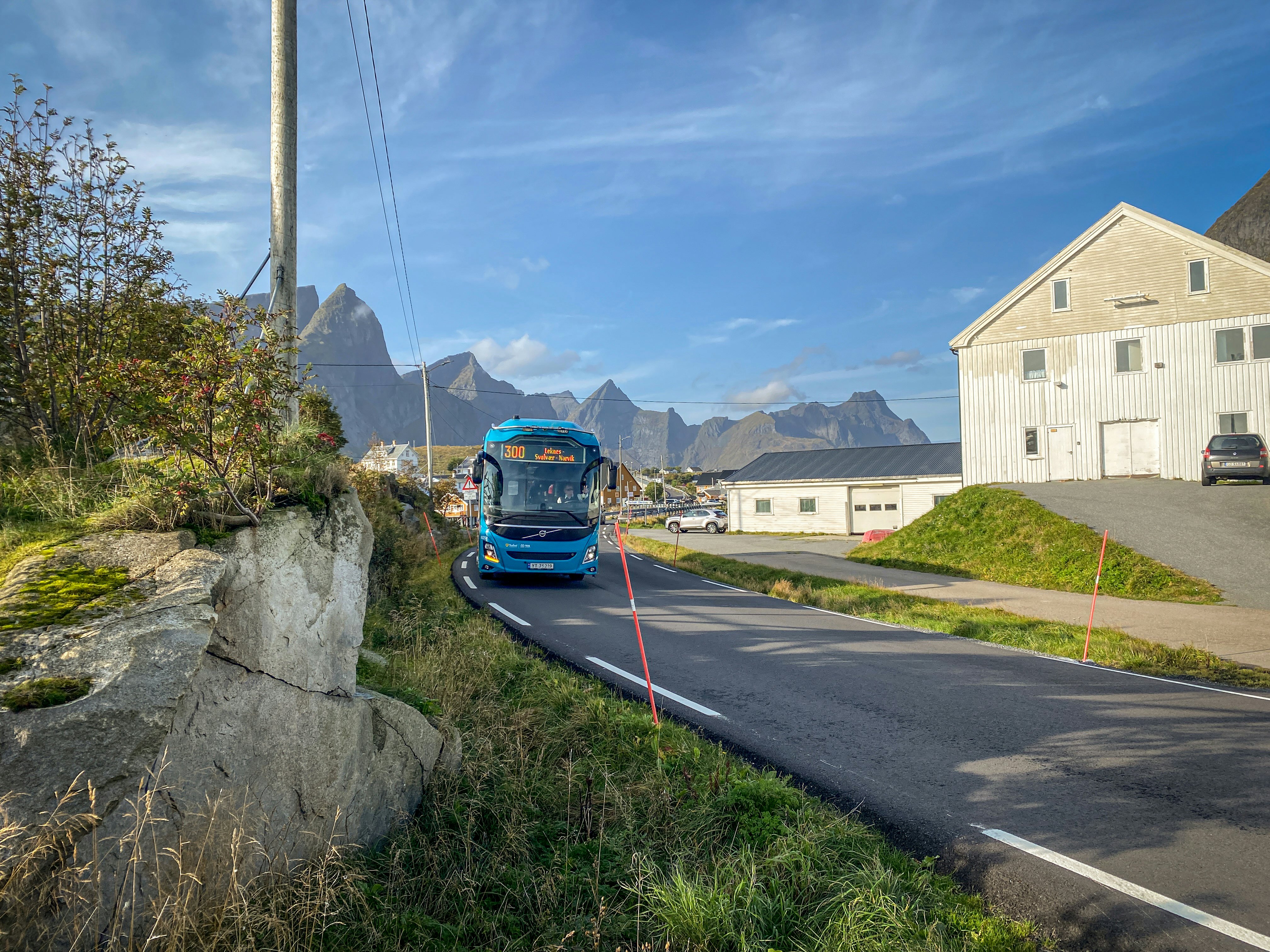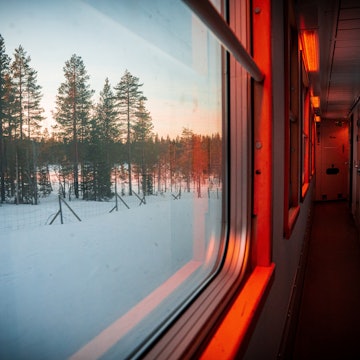
Slow Travel: Crossing the Arctic Circle by train - in pursuit of the Northern Lights

Jan 5, 2024 • 10 min read

The aurora borealis above the Swedish city of Luleå © Daniel James Clarke
Our slow travel series explores how you can take more mindful journeys by train, boat, bus, or bike – with tips on how to reach your destination without flying, and what to see and do along the way. Here, Daniel James Clarke explains how he traveled from Lapland to the Lofoten Islands, crossing the Arctic Circle aboard two of Scandinavia’s most scenic train journeys.
For centuries, Norway’s majestic Lofoten Islands have enticed travelers to cross the Arctic Circle in pursuit of pristine panoramas and aurora borealis (northern lights) sightings.
To traverse this ethereal archipelago had been a distant dream of mine for years. But I thought the islands were too remote, too costly, and too challenging to visit without a car.
Determined to fulfill my long-held goal of crossing Lapland to the Lofoten Islands, I finally booked a trip as the equinox loomed last fall. I timed my visit to coincide with the peak of the 11-year solar cycle, which promised a significant season of northern lights.
Thankfully, my concerns proved unfounded. Traveling to Norway by public transport wasn’t just seamless, but off-season its scenic train journeys were also surprisingly affordable, especially reserved in advance.
I cobbled together a connection from Rovaniemi in Finnish Lapland to join Sweden’s Arctic Circle Train at Luleå (a three-bus combo via Kemi and HaparandaTornio, if you're considering the same). I then eagerly booked daytime tickets, so as not to miss any landscapes – a lesson from the Oslo to Bergen sleeper.

Swedish Lapland to Norway: the Luleå to Narvik train
I was already exhausted as I reached Luleå train station for the 5:13 am departure to Norway because the aurora borealis had appeared unexpectedly in the early hours. I'd eschewed sleep to witness my first spectacle: lime green and scarlet ribbons that danced deliriously in the skies overhead.
Luckily, the seats were comfortable in the carriage, a semi-enclosed space with some seats against the window.
With a short whistle, our seven-and-a-half hour, 473km (293 miles) journey began – only to soon stall at Boden station whilst the driver attached two carriages from the overnight service from Stockholm, a true south-to-north 18-hour odyssey.

The first couple of hours passed with little to report until we unceremoniously crossed the Arctic Circle line at minuscule Murjek station. Then we picked up the pace and the panoramas I'd waited patiently to see materialized near Gällivare. Ridges flanked the tracks and we were surrounded on both sides by dense pine forest. The fresh snow was periodically punctuated by lakes.
As we rolled into Kiruna, fabled for its vast underground iron ore mines, we pulled up alongside dirt-stained wagons used to shuttle mineral-rich deposits toward the port at Luleå. The Malmbanan (Iron Ore Line) was initially constructed in 1888 to connect Malmberget with Svartön in Luleå to transport the treasured iron ore. It’s unlikely it would have been built otherwise.
There was a brief pause at the station to stretch our legs on the icy platform. Some passengers debarked for tours of the mine, others to stay over in the nearby Ice Hotel. When the train started again, it resumed in reverse.
Abisko National Park was cinematic as we crossed it. High alpine autumnal hues framed the vast Torneträsk lake with shades of rust and amber, while the snow-sprinkled mountains reflected of its icy waters.

The train stopped at Abisko Östra station and passengers got another moment outside. We gawked at Tjuonavagge, a dramatic half-moon-shaped valley known as the 'The Lapponian Gate’ before the train trundled towards the rugged frontier to join Norway's Ofoten Line.
The train guard appeared and announced that we'd shortly descend to the Rombaken fjord where a submerged German WWII destroyer Georg Thiele is still visible on a clear summer day.
Camera shutters went into overdrive as they captured the steep slopes, plunging cascades, and the shockingly blue waters below. Too soon, it was all over; we glided into Narvik just behind schedule.

Slowing down: the Lofoten Islands by bus
I'd originally intended to travel south from Narvik to Skutvik so I could take the ferry to Svolvær and spend six days on Vestvågøya and Moskenesøya, the two furthest Lofoten Islands. Realizing it was a tad convoluted, I changed tack and caught the direct 3:50 pm bus to Leknes instead. The journey took almost six hours. But those first glimpses of Lofoten's cloud-shrouded peaks as they rose from the Norwegian Sea left me enthralled long after twilight.
The following day, any worries about tackling one of the most lauded road trips in Norway by bus had subsided. Even out-of-season schedules are regular enough to visit the towns, trails, and attractions along the E10, the islands' main road.
Seamless transfers and my unlimited bus pass made getting around the Lofoten Islands by bus effortless and affordable. I took connecting services to remote villages and spectacular, if chilly, beaches.

I headed to mountain-flanked Reine where the traditional, turf-roofed, red Rorbu fishing cabins were even prettier than I’d pictured. The Caribbean-esque sands and crystalline waters at Haukland Beach also surpassed all the hype. In Å, an end-of-the-road fishing village, the Norsk Fiskeværsmuseum educated me on seafaring sagas via a cluster of weathered buildings.
I felt far more present traveling slowly. I relished each moment rather than being fixated on reaching the next vantage point.

A free ferry back to Bodø
Å is the last letter in the Norwegian alphabet. It also proved a strategic endpoint. Unlike the buses from Lofoten’s eastern towns, the village's early-hour ride connects with the 7:00 am Moskenes–Bodø ferry.
I arrived at the port and bypassed the waiting cars (foot passengers travel for free; vehicles need to pre-book and pay). I strolled onto the parking deck and wrote my name on the passenger list – all far too easy. We departed 15 minutes late, and I wistfully watched the Lofoten Islands fade behind a wall of drizzle from the open deck before I fled to the warmth of the cafe for sunrise.
The crossing took around three hours. Ample time to connect to the southbound train to Trondheim, which had been my initial plan. Yet I decided to stay overnight in Bodø and tour a few sights.
The port rarely features on any list of Norway's top destinations – other than for its proximity to Saltstraumen, home to the world’s strongest maelstrom – but it is one of the EU Capitals of Culture 2024. Indeed, the first ever in the Arctic Circle. Sadly, the much-touted Nordlandmuseet was closed for renovations. Once it has reopened, though, the extended space will increase its spotlight on indigenous Sami art and culture.

Back across the Arctic Circle: Bodø to Trondheim by train
Having slept directly above the train terminal at the Bodø Hostel & Motel, it took seconds to reach the four-carriage 12:27 pm Nordlandsbanen to Trondheim service which was already waiting on the platform when I arrived. Still, there was no rush to embark; we’d all have plenty of time aboard Norway's longest rail line.
The train departed on time and we hugged the handsome Skjerstad Fjord. The occasional ruby-red cabin added color to an otherwise dreary day. The windows on the other side of the carriage framed waterfalls but I was content in the fjord-facing seats on the right-hand side. Soon we plunged into darkness anyway as we entered the first of 154 tunnels along the 729km (453 miles) route.
We snaked beside the thrashing rapids of the Lønselva River and ascended into the Saltfjellet mountain range. As the mist outside broke, a barren terrain of knotted ice-capped peaks guided us to the track's highest point, 680 meters (2230ft) above sea level.

A group of well-insulated hikers alighted at Lønsdal, presumably to explore the trails and glacier at Saltfjellet-Svartisen National Park. An announcement followed shortly that had everyone's noses pressed against the windows: we were about to cross the Arctic Circle.
We dawdled past the cairn-like markers that denoted the latitude line, followed by the domed Arctic Circle Centre. For many, this was the pinnacle of the journey. Fellow passengers then busied themselves with knitting needles or laptops. Restless souls retired to the restaurant cart.
Dunderland station offered passengers a brief interlude as – almost on cue – the temperature flickered into double digits. Sunlight now gleamed across an emerald-green river as spruce superseded pine. The canopy's colors shifted from copper to crimson until finally resting on verdant pastures.
Shortly after mirror-like Lake Majavatnet, we transited the regional border into Trøndelag as the sun faded. My neighbor’s knitted scarf was nearly complete. I’m sure those in the family railcar were grateful for the kid's play area. Hot dogs, meatballs, and hot chocolates from the restaurant cart broke up the final unilluminated stretch. After nearly 10 hours, Trondheim station was a welcome sight. The scenery had been arresting, but I was thankful to be out in the fresh Norwegian air again.

Onwards to Oslo
With the direct night train connection to Oslo suspended due to a bridge collapse in August 2023 (services should resume in the spring or summer of 2024), I’d planned to stay overnight in Trondheim, Norway's third-largest city.
The following day, I had ample time to tour Trondheim's highlights, such as the remarkable embellished facade of the 12th-century Gothic Nidaros Cathedral and the hilltop Kristiansten Fortress. I strolled the cobbled streets of the Bakklandet neighborhood with its colorful river-facing wooden houses.
The last leg of my journey was the 10:45 pm Vy night bus to Oslo, which I had been apprehensive about. Yet I was pleasantly surprised. My reclinable Plus seat was wide and with no neighbor. It also had extra legroom, which allowed for a comfortable slumber.
After traversing more than 2000km (1243 miles) over the last nine days, I slept like a log – dreaming of those kaleidoscopic dancing skies all the way to Norway’s capital.

How to make it happen
Tickets
I booked my train tickets a few weeks ahead: Luleå–Narvik for 494 SEK and Bodø–Trondheim for 539 NOK (around US$52; last-minute prices can cost nearly double). Tickets are generally released 90–120 days in advance, and you can make reservations on the national operators’ websites: SJ and Vy.
In Lofoten, the Travel Pass Nordland (1290 NOK; around US$125) provides seven days of unlimited bus travel. Physical cards are only purchasable in Bodø, so it’s best to buy online using the Reis Nordland app. Single tickets are cheaper if taking infrequent bus journeys; however, given a one-way ticket from Narvik to Leknes costs 512 NOK ; around US$50, the savings can quickly add up.
Food and drink
On the Luleå–Narvik service, a kiosk sells hot and cold snacks and drinks – download the VY app to receive a free coffee. From Bodø–Trondheim, daytime departures have a restaurant cart, serving reasonably priced (by Scandinavian standards) hot meals, soft drinks and (less affordable) alcoholic beverages. Premium Plus passengers receive complimentary hot beverages and snacks and can order meals directly to their seats. Alternatively, pack a picnic to save some krone.
Facilities
Both trains are equipped with plug sockets and (sometimes patchy) wi-fi, as are most of the Nordland buses – handy, as the travel pass generates validation via an internet connection. Bodø and Trondheim train stations have spacious self-service luggage lockers that accept card payments; Narvik’s lockers require Norwegian coins. Most Nordland buses have helpful onboard information screens, dedicated reversible child seats, and complimentary bicycle racks on certain services.
Plan your visit by season
The experience varies considerably by season; plan accordingly. In winter, short days curtail the window for admiring frozen landscapes, while overnight trains may present northern light viewing opportunities. Summer's polar nights can turn the sleeper service scenic. Trains operate daily year-round, but buses and ferries have reduced services outside June-September, meaning a little planning is needed to align the days ferries operate with onward trains. Use the Reis Nordland travel planner to firm up your itinerary.













